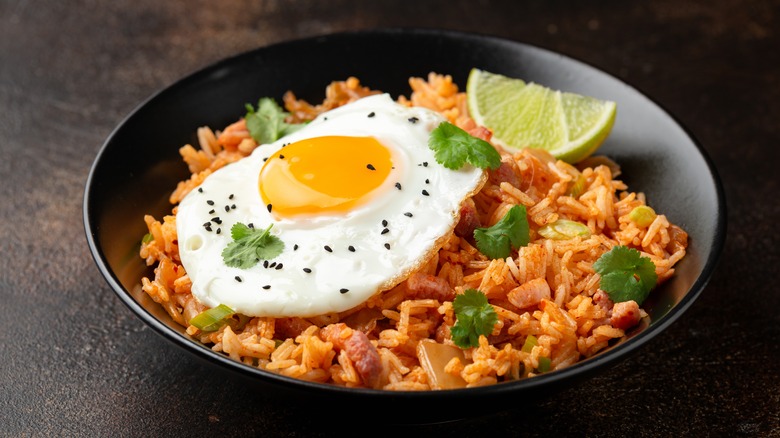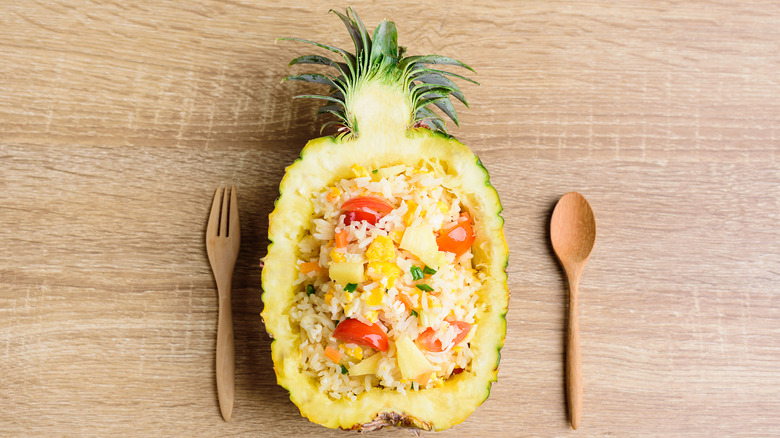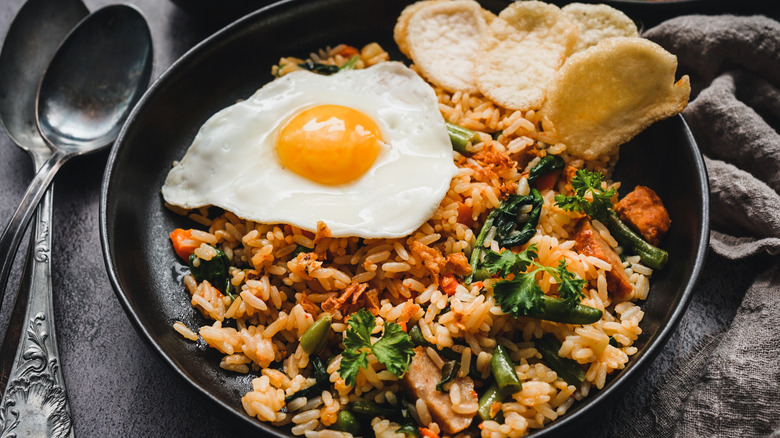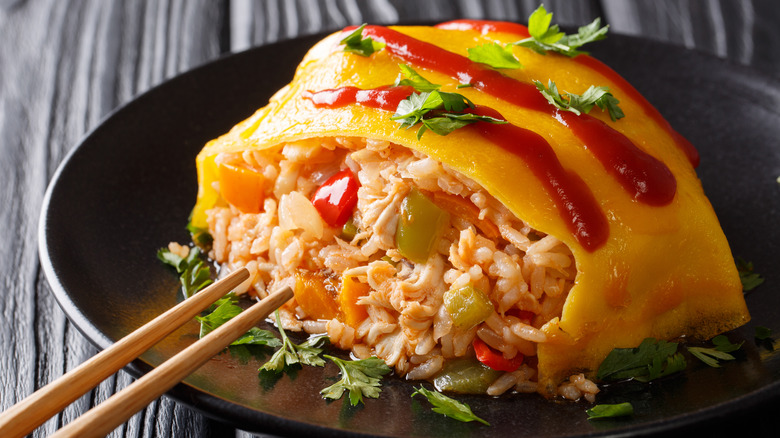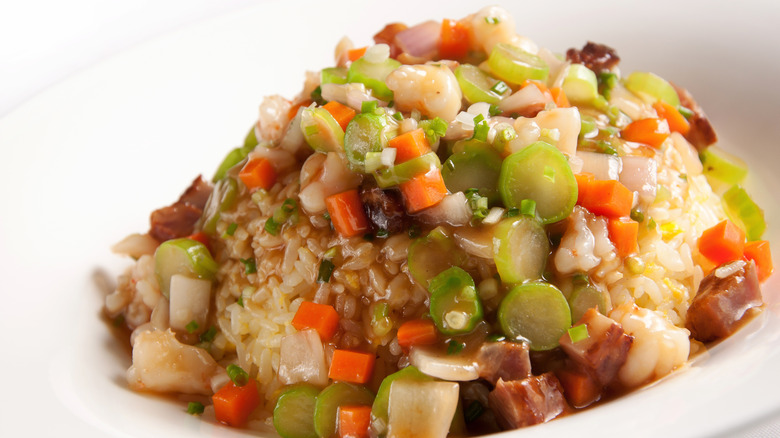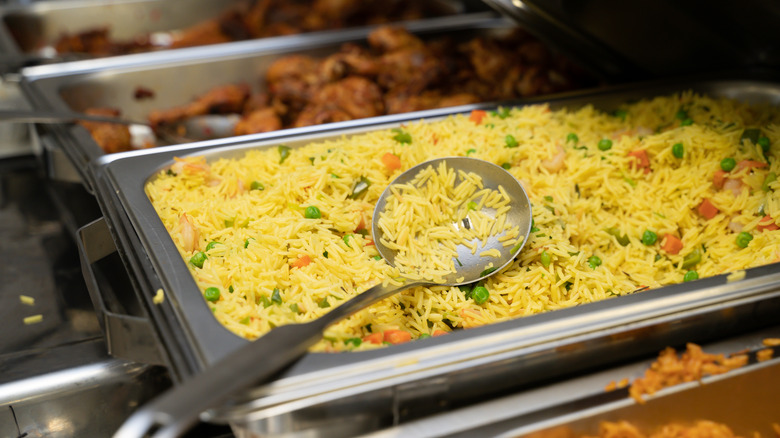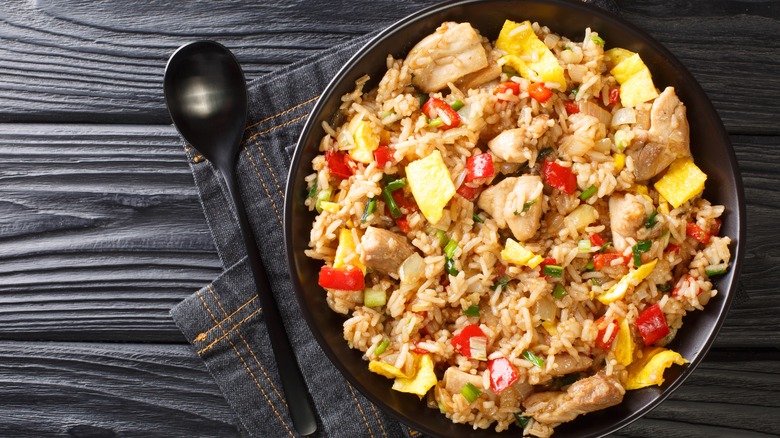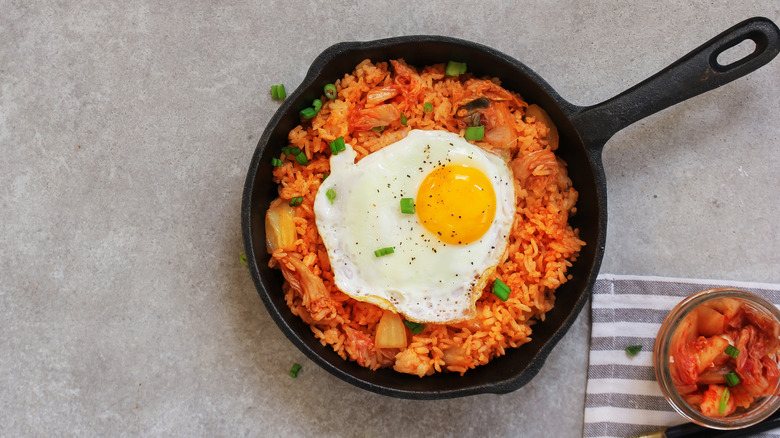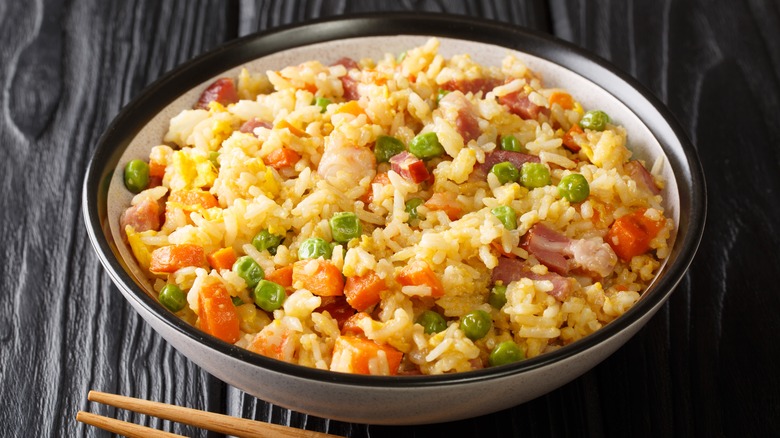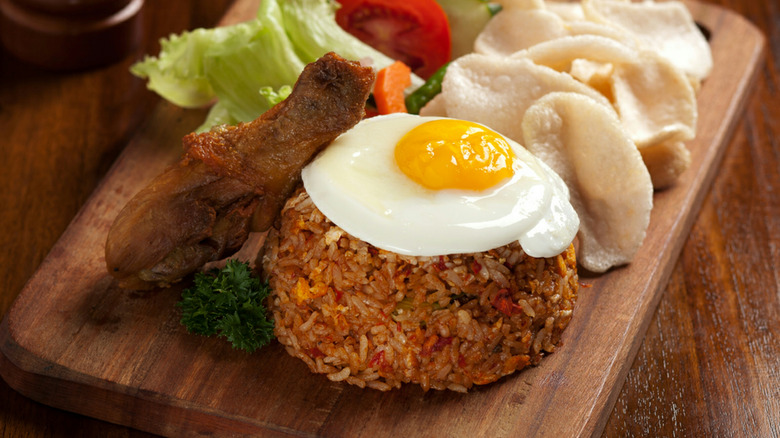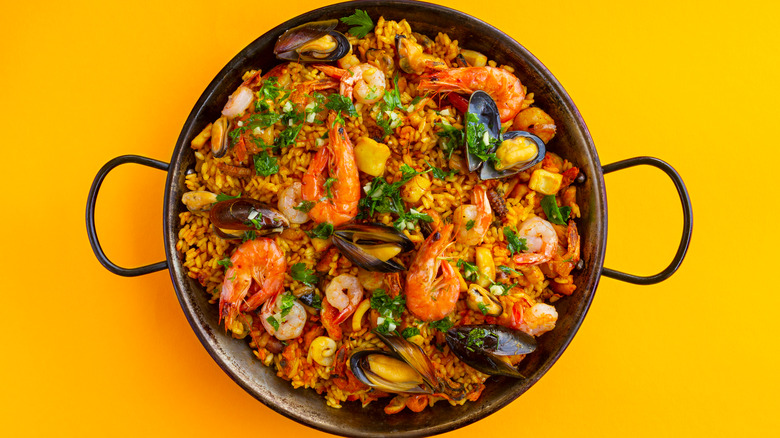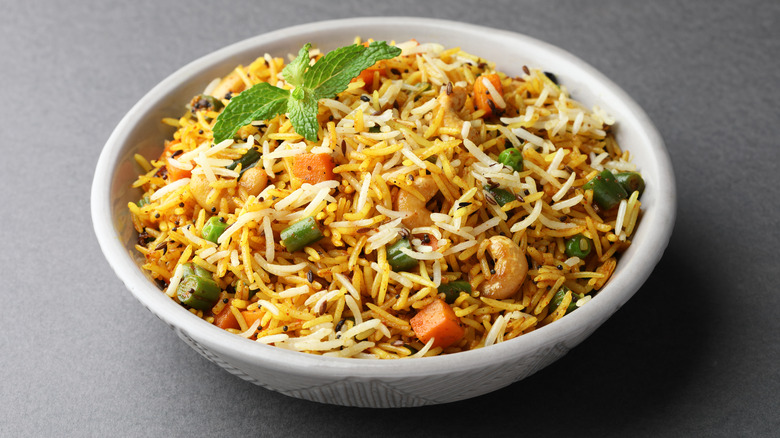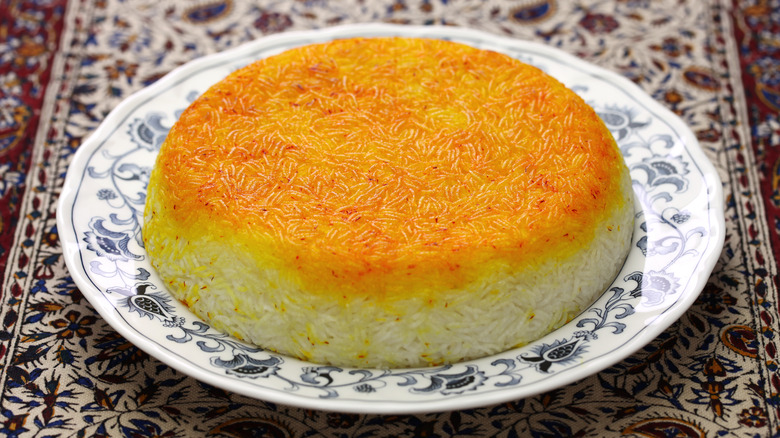12 Ways People Enjoy Fried Rice Around The World
For some people, a simple rice bowl is as good as it gets. Those carby, fluffy grains, that serve as the ideal base for a host of dishes are damn near unbeatable — unless you're frying that rice bowl into a fried rice dish that'll make your guest's mouths water.
Fried rice is an easy-to-prepare dish that most of us have eaten in our lifetimes. With its origins in ancient eastern China, fried rice became popular as a way of repurposing leftover rice and other food scraps into a standalone meal. Over the years, its popularity has persisted, and today, fried rice can be found in virtually every Chinese restaurant across America.
Understandably, then, when people think of fried rice, their minds usually leap to the classic Chinese version of the dish. But the truth is, there are far more variations of fried rice than the type you normally get from your local take-out. Multiple countries have their own versions of fried rice as part of their national cuisine, with specific flavor profiles, ingredients, and cooking styles. And we're here to shine a light on some of our favorites from around the world.
1. Khao pad sapparod (Thailand)
While fried rice is certainly delicious, it's not often the most visually impressive dish out there. But khao pad sapparod, a Thai take on fried rice, will have eyes popping as it comes to the table. Khao pad sapparod is probably the best fried rice dish you haven't tried, and it is notable for its serving style, with the piping hot fried rice piled into a halved, hollowed-out pineapple. This method of delivering the rice to hungry mouths isn't just for aesthetic flair, either. Doing so also allows the fried rice to soak up a little sweetness, adding further layers of flavor to your meal. And it also saves on washing up, too.
Khao pad sapparod allegedly has origins in the Thai-Chinese community, and this is arguably reflected in its flavors and preparation method. The dish combines the cooking style of classic fried rice with typical Thai ingredients like fish sauce. Soy and oyster sauce also often make an appearance in khao pad sapparod recipes, with chefs frequently adding garlic, cilantro, and a range of proteins. Jasmine rice is typically used to create khao pad sapparod, which is best cooked in advance and left to dry out slightly before being fried to perfection. Trust us, once you try this fried rice dish, you won't look back.
2. Nasi goreng (Indonesia)
If you've ever eaten at an Indonesian restaurant, you'll likely have seen nasi goreng on the menu. And if you then went ahead and ordered it, it's a fair guess that you'll have left pretty satisfied. Nasi goreng is a fried rice dish that is as versatile as it is delicious. Like Chinese fried rice, nasi goreng provides a vehicle for a host of leftover ingredients you have in your fridge. Originating in Chinese communities that moved to Indonesia, over the years it has evolved to become a staple menu item that can be served at any time of the day.
What distinguishes nasi goreng from other fried rice dishes is the inclusion of kecap manis. This Indonesian soy sauce, made with warming spices like cinnamon and cloves, is a sweet, thick condiment that provides slightly smokey notes to your fried rice meal. Nasi goreng is also often made with sambal, a chili sauce that gives piquancy to the dish. The meal is often finished off with a fried egg served on top of the rice, and with a side of fresh vegetables.
3. Omurice (Japan)
Omurice impresses on two levels: its delectable taste and its delightful serving method. This Japanese fried rice dish literally combines the words "omelet" and "rice," a clue as to what to expect when you order it. And for those who do take the plunge, they're rewarded with a fluffy mound of fried rice, with an omelet balanced on top. The omelet is then traditionally sliced open, with the creamy interior allowed to cascade down over the hot rice. It's a culinary sensation, y'all.
The flavors of omurice hint toward its origins, which occurred when Western food items like ketchup started to make their way to Japan. The fried rice dish is typically made with ketchup, both squirted into the rice itself and sometimes drizzled on top of the omelet. The inclusion of ketchup in omurice recipes gives the rice a tang and sweetness. Soy sauce also boosts the umami factor of the rice, which the ketchup also provides. As with other fried rice dishes, omurice lends itself well to being a vehicle for leftover food items that need to be used up, with peas, carrots, and protein often added. Let's be real, though: it's all about that fluffy omelet on top.
4. Fujian fried rice (China)
It's easy to think of Chinese fried rice as a one-size-fits-all dish. But while standard takeout fried rice can be pretty similar regardless of where you order it, traditional Chinese cuisine has its own distinct versions of fried rice. Individual styles of fried rice dishes differ depending on the province that the food originates from. And the Fujian province, situated in the southeast of the country, has fried rice that may be slightly different from the Chinese food you're accustomed to.
Fujian fried rice often incorporates seafood in a style typical of the coastal Fujian province. But that's likely not the first thing you'll notice if you order it in a restaurant. Arguably the most striking thing about Fujian fried rice is its wetness. This fried rice variation is created by frying together rice, eggs, and seasonings in a super-hot wok. Then, the proteins and vegetables are fried and combined with liquid, with cornstarch added to make a thick, shiny sauce. This sauce is then poured over the dry rice, with the whole thing served on a big plate to hungry guests. The addition of five-spice powder also helps to give the meal an aromatic edge.
5. Nigerian fried rice (Nigeria)
While fried rice dishes are common across the Asian continent, countries across the world have their take on the dish. And Nigerian fried rice is a style that you definitely need to try. The dish is one of a host of Nigerian rice-based meals and utilizes flavors that are a little different from Chinese fried rice. While Chinese-style fried rice tends to incorporate flavors of soy, egg, and whatever vegetables you have on hand, Nigerian-style fried rice tends to amp up the spice. Curry powder, dried chilies, and turmeric are often present in Nigerian fried rice, with the herbal notes of thyme also making an appearance.
The preparation for the rice itself, even before you fry it, is also different. Nigerian fried rice is generally prepared using long-grain or basmati rice cooked in a special stock. This stock, usually flavored with curry powder and ginger, permeates the rice, amping up the taste of the eventual meal. As with Chinese fried rice, a range of protein options can also be added to the dish. Vegetables are also frequently added, to provide flavor, fiber, and crunch.
6. Arroz chaufa de pollo (Peru)
The movement of communities from one part of the world to another can have a huge influence on food, creating brand-new dishes informed by location and history. This is the case with arroz chaufa de pollo, a Peruvian fried rice dish created by Chinese immigrants who moved to Peru. These immigrants, often paid partially in rice for their work, would use the grains to cook. Today, arroz chaufa de pollo has evolved into a commonplace dish in Chinese-Peruvian cuisine.
While chicken is the most frequently-used protein in this fried rice meal, it's possible to use any meat or seafood you like. What's particularly notable about arroz chaufa de pollo is how similar it is at first glance to classic Chinese fried rice. The dish uses the flavors of soy, sesame, and spring onion as its primary flavor profile, with ginger and garlic also making an appearance. Egg is also commonly present in arroz chaufa de pollo, with beaten eggs cooked into an omelet, that's then sliced and added to the rice mixture. Arroz chaufa de pollo is usually eaten alongside other main dishes but is satisfying (and tasty) enough to enjoy on its own.
7. Kimchi fried rice (Korea)
Kimchi is a staple in Korean cuisine, and, as well as acting as an accompaniment for other foods, it can also be used to flavor dishes. And one such example of this is its use in kimchi fried rice. As you might expect, kimchi fried rice is created by, well, frying kimchi with rice. This gives your fried rice dish an unmistakable tangy, funky flavor, and can boost its saltiness without having to reach for the soy sauce.
As well as adding great taste, using kimchi in fried rice is a great way to boost your probiotic intake, which your gut and immune system will thank you for. Kimchi fried rice includes further bold flavors through the addition of garlic and ginger. For further Korean flavors, gochujang, a fermented red pepper paste, can also be added, ideally mixed with butter and spooned on top of the fried rice. This will give your dish both a spicy kick and a sense of luxury and indulgence from the butter. While any protein can be used in kimchi fried rice, bacon and other pork cuts pair well with the forthright flavors.
8. Yangzhou fried rice (China)
Classic Chinese fried rice is thought to have been born in the city of Yangzhou. But today, Yangzhou fried rice is a distinct style of its own. Yangzhou fried rice is similar in style to golden fried rice, where each rice grain is coated in egg yolk, giving it a lustrous color. However, while a classic golden fried rice dish is generally made without any additions, Yangzhou fried rice is packed full of other ingredients.
Importantly, Yangzhou fried rice frequently contains multiple protein sources, all coming together to create a multi-layered flavor. It's also important to remember that, unlike other types of fried rice, here the eggs and rice are cooked together. The rice is added when the eggs are partially cooked in the smoking hot wok. By doing this, the rice becomes gently enveloped by the still-soft egg, giving the whole dish a golden hue. The whole dish is flavored with a combination of stock and shaoxing wine, and the result is a vibrant plate of food that the entire family can enjoy.
9. Nasi goreng kampung (Malaysia)
Nasi goreng (which literally translates to "fried rice") is a highly popular dish in both Malaysia and Indonesia. But there remains a dispute over which country can lay true claim over the dish. The truth, though, is that nasi goreng exists in slightly different forms in each nation. And nasi goreng kampung, Malaysian-style fried rice, is worth a try.
Nasi goreng kampung has some pretty bold flavors going on, with the inclusion of crispy anchovies and fish sauce giving an umami kick. The briny notes given by the fish are amped up by adding a small amount of belacan paste, also known as shrimp paste. Although these ultra-fishy ingredients might put some people off, the result is a seriously deep flavor. The addition of kecap manis also gives a slightly sweet edge, while reinforcing the salty smack given by the seafood-based ingredients, with sambal providing the spice. Your protein of choice keeps the dish filling, and the whole thing is topped off with a fried egg, fried shallots, cucumber, and spring onion. Does it get any better than that?
10. Paella (Spain)
Fried rice dishes don't get much more visually impressive than paella. One of the key dishes of Valencia, paella is separated from other fried rice dishes by its cooking method, flavors, and the unique dish it's traditionally prepared in. Rather than the rice being pre-cooked and seared in a hot wok, paella rice is fried raw and simmered with other ingredients in a wide, flat pan. As well as making the whole dish look pretty darn good, it also ensures the rice cooks evenly, and crisps gently on the bottom.
Traditional paella is usually made with short-grain rice like the Bomba variety. Bomba has a hardiness that allows it to withstand the longer simmering times needed to make paella without breaking down. The flavors of classic paella are also pretty distinctive. Paella gains both taste and color from adding saffron, a luxurious, ruby-red spice that imparts golden tones into the rice. As Valencia is a coastal city, paella often contains seafood as a protein source, with mussels and shrimp common in the dish. However, the dish can often contain chicken, chorizo, and even rabbit.
11. Vagharelo bhaat (India)
Rice is a common feature in Indian cuisine and is served both as a side and as the main event, such as in biryani dishes. Typically, though, when we think of Indian food, we don't think of fried rice. But India has a hugely diverse culinary landscape, and in certain parts of the country, like Gujarat, fried rice dishes are on the menu. Known for its subtle and sweet flavors, Gujarati cuisine commonly uses rice and gentle spices. And all of these come together in vagharelo bhaat.
Meaning fried rice in Gujarati, vagharelo bhaat is a great way to use up any leftover basmati rice you have from last night's meal. The dish combines everyday Indian spices like cumin seeds, turmeric, and a hint of red chili powder, with garlic and red onion. Paneer is used for the protein element, in keeping with Gujarat's primarily vegetarian sensibilities. The dish is made by first sautéeing the spices, vegetables, and aromatics together, throwing in cashew nuts if you wish for a little crunch. Then, add your protein, followed by the rice, and fry it all together. Finish it off with a hit of cilantro on top, and you're good to go.
12. Tahdig (Iran)
As fried rice dishes go, few are as striking as tahdig. This Iranian dish goes against the fried rice recipes you may be accustomed to, and instead almost resembles a cake. Tahdig is made by layering rice on top of a base coating of a mixture of rice, yogurt, and spices, in a large pot. Then, the heat is cranked up, and the dish is left to steam together, while the bottom layer of rice fries and crisps up.
The result is apparent when you serve the tahdig, by flipping it out onto a platter in one go. The bottom layer of rice becomes crispy and crunchy, with a deep golden color. The rest of the rice, meanwhile, remains soft and fluffy.
Tahdig often contains lashings of butter to make it extra indulgent, and it can be prepared to be sweet, savory, or both. Try throwing cherries and sultanas into your tahdig, or add nuts, potatoes, and savory spices. And the best part is, tahdig can be eaten for any occasion, as a main meal, or accompanying a range of foods. We think we've found our new favorite fried rice dish, people!
Static Media owns and operates Daily Meal and Tasting Table.
